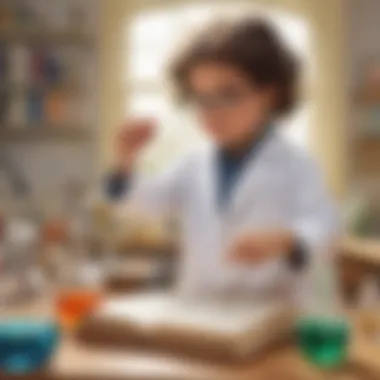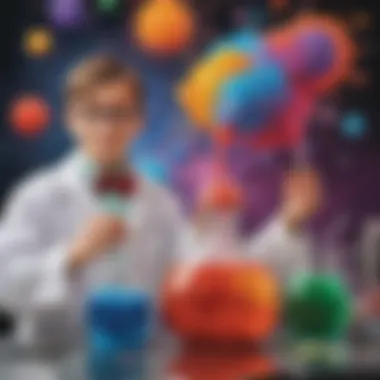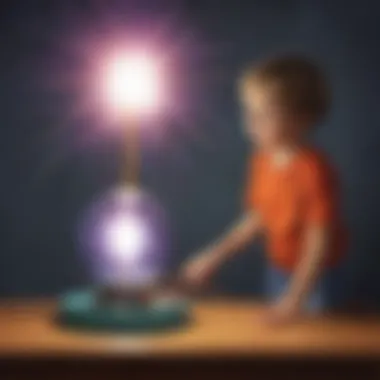Engage Young Minds with These Fascinating Science Activities for 5-Year-Olds


Fun Activities Ideas
As we delve into a world of discovery and understanding, engaging young minds in captivating science experiments can spark a lifelong curiosity for exploration. For our curious 5-year-olds, these science experiments serve as the gateway to a realm where questions lead to answers, and curiosity drives learning. By incorporating fun and educational activities tailored to their developmental stage, we lay the foundation for their future scientific endeavors. From simple yet mesmerizing indoor experiments to nature-inspired outdoor quests, the world of science unfolds before their eyes, inviting them to unravel its mysteries right from the comfort of home.
Introduction to Science Experiments
Science experiments are a fantastic way to engage young minds in the wonders of the world. In this article, we delve into exciting experiments tailored specifically for 5-year-olds, providing hands-on learning experiences from the comfort of home. These experiments aim to spark curiosity, foster a love for exploration, and enhance early learning through interactive play.
Importance of Early Science Exposure
Developing Curiosity
Developing curiosity in young children is crucial as it lays the foundation for a lifelong journey of learning and discovery. By encouraging them to question the world around them, we ignite a spark that fuels their thirst for knowledge. Curiosity drives children to seek answers, fostering a sense of wonder and excitement towards science experiments. In this article, we explore how nurturing curiosity can lead to a deeper understanding of scientific concepts and cultivate a passion for exploration.
Encouraging Critical Thinking
Critical thinking is a vital skill that every child should develop from a young age. By encouraging critical thinking in science experiments, we prompt children to analyze information, evaluate evidence, and form logical conclusions. This article emphasizes the importance of fostering critical thinking skills through hands-on activities that challenge children to think creatively and problem-solve. Engaging in scientific inquiries at a young age can enhance cognitive abilities and lay the groundwork for analytical thinking in later stages of their education.
Fostering a Love for Learning
Fostering a love for learning is essential in nurturing a child's intellectual growth and development. By instilling a passion for exploration and discovery, we create a positive attitude towards education that can last a lifetime. This article explores how science experiments can be a catalyst for igniting a love for learning in 5-year-olds. By making learning fun and interactive, we not only enrich their educational experience but also instill a sense of inquisitiveness that propels them to seek knowledge proactively.
Setting the Stage for Learning


Creating a Safe Environment
Creating a safe environment for science experiments is paramount to ensure the well-being of young minds. Emphasizing safety measures and precautions not only protects children from harm but also instills responsible behavior during scientific explorations. This article highlights the importance of setting up a safe space for conducting experiments, including factors such as proper supervision, hazard awareness, and emergency preparedness. By prioritizing safety, we create an environment where children can learn and explore without unnecessary risks.
Emphasizing Exploration and Observation
Encouraging children to explore and observe their surroundings is fundamental to their scientific development. By emphasizing the value of hands-on exploration, we enable them to discover scientific phenomena firsthand, fostering a deeper understanding of natural processes. This article delves into the benefits of promoting exploration and observation in young learners, explaining how these activities enhance their cognitive skills, sensory perception, and analytical thinking. Through engaging in sensory experiences and making insightful observations, children can develop a holistic understanding of scientific concepts.
Encouraging Questions and Discussions
Encouraging children to ask questions and engage in discussions is key to nurturing their curiosity and critical thinking skills. By creating an environment where curiosity is welcomed and questions are valued, we empower children to explore ideas, seek explanations, and communicate their thoughts effectively. This article underscores the importance of fostering a culture of inquiry and dialogue in science experiments, emphasizing the role of open-ended questioning and active communication. By encouraging children to articulate their thoughts and engage in scientific discourse, we enhance their learning experiences and promote intellectual growth.
Simple and Engaging Experiments
As we embark on a journey to introduce young minds to the wonders of science, the section of Simple and Engaging Experiments plays a pivotal role. Simple and Engaging Experiments serve as the foundation for igniting curiosity and fostering a love for learning in 5-year-olds. By conducting hands-on experiments at home, children can develop crucial skills like observation, critical thinking, and problem-solving. These experiments are specially crafted to capture their attention, making learning a fun and interactive experience. Parents, teachers, and guardians can utilize these experiments to introduce scientific concepts in a way that is both entertaining and educational, setting the stage for a lifelong curiosity of the world around them.
Rainbow Milk Art
Materials Needed:
Rainbow Milk Art is a visual delight that requires a few essential materials to create a mesmerizing effect. To carry out this experiment, you will need whole milk, liquid food colors, dish soap, a shallow dish, and cotton swabs. These materials are carefully chosen to produce vibrant and swirling colors when combined, engaging the child's senses and sparking their artistic exploration.
Step-by-Step Instructions:


The process of creating Rainbow Milk Art involves simple and engaging steps that are easy for young children to follow. Begin by pouring the milk into the dish, add drops of different colored food dye, and then gently touch the surface with a cotton swab dipped in dish soap. Watch in amazement as the colors dance and swirl, creating a beautiful masterpiece right before your eyes. This step-by-step approach not only entertains but also educates children on the interaction between different substances, fostering an understanding of basic chemical reactions.
Scientific Concept Explained:
The magic behind Rainbow Milk Art lies in the scientific principles of surface tension and molecular interactions. When the dish soap is introduced to the milk, it breaks the surface tension and disrupts the molecules, causing the colors to swirl and mix. This simple yet fascinating experiment helps children grasp the concept of chemical interactions in a visual and hands-on manner, laying the groundwork for more complex scientific ideas in the future.
Exploration Through Play
In the realm of early childhood education, Exploration Through Play stands as a critical pillar that promotes holistic development and cognitive growth in young minds. At the tender age of 5, children thrive on hands-on experiences that engage their senses and foster intrinsic curiosity. By incorporating play into science experiments, not only are fundamental scientific concepts introduced, but also vital skills such as problem-solving, motor skills development, and creativity are nurtured. This section will delve into the significance of sensory play for 5-year-olds, highlighting the transformative benefits it brings to their learning journey.
Sensory Bottle Creations
Required Materials:
Sensory Bottle Creations necessitate readily available materials such as clear plastic bottles, water, food coloring, glitter, and various small objects like buttons or beads. These elements combine to create a visually stimulating and tactile sensory experience for young children, allowing for exploration of colors, shapes, and textures. The versatility of these materials enables endless variations, engaging children in observing cause and effect relationships and enhancing their fine motor skills.
Stepwise Creation:
The stepwise creation of sensory bottles involves a straightforward process of filling the clear bottle with water, adding drops of food coloring, glitter, and selected small objects, and sealing the bottle tightly. This methodical approach not only captivates the child's attention but also instills a sense of accomplishment as they witness the sensory bottle come to life with colors and floating objects. Following each step promotes sequential thinking and attention to detail in young learners.
Sensory Learning Benefits:
The benefits of engaging in sensory bottle creations extend beyond mere play; they serve as valuable tools for sensory exploration and self-regulation. By manipulating the bottle and observing the swirling colors and objects, children engage their tactile and visual senses, stimulating cognitive processing. Furthermore, the calming effect of sensory bottles can assist in regulating emotions and promoting focus, making them advantageous not only for play but also for emotional development and learning readiness.


Safety Precautions and Parental Guidance
In the realm of conducting science experiments with young children, ensuring safety precautions and providing proper parental guidance are paramount aspects that should not be overlooked. Safety precautions serve as the foundation for a secure and risk-free scientific exploration environment, enhancing the overall learning experience. By prioritizing safety measures, parents can instill a sense of responsibility and awareness in children at a tender age. Moreover, parental guidance plays a crucial role in navigating children through the intricate world of science, fostering a supportive and enriching learning atmosphere. Through thoughtful supervision and instructive discussions, parents can cultivate a lifelong passion for scientific inquiry and discovery in their little scientists.
Ensuring a Safe Environment
Supervision Requirements
Supervision requirements form the cornerstone of maintaining a safe environment during science experiments for 5-year-olds. This aspect emphasizes the necessity of close monitoring by adults to prevent accidents and address potential hazards promptly. The key characteristic of supervision requirements lies in the continuous presence of an attentive adult who guides and oversees the experiment progression. This hands-on approach ensures real-time intervention if any safety concerns emerge, making it a reliable and popular choice for ensuring a secure scientific exploration for young children. The unique feature of supervision requirements is its ability to provide immediate assistance and guidance, thus minimizing risks while encouraging independent learning in the young learners.
Proper Handling of Materials
Proper handling of materials is another crucial element contributing to the overall safety of science experiments for 5-year-olds. This aspect underscores the significance of age-appropriate tools and supplies to mitigate potential dangers and ensure a controlled experimental setting. The key characteristic of proper handling of materials is the careful organization and distribution of equipment, emphasizing neatness and orderliness to prevent accidents or mishaps. This careful approach is a beneficial choice for this article as it instills discipline and responsibility in young scientists, promoting a sense of respect towards scientific tools and resources. The unique feature of proper handling of materials is its emphasis on adhering to established safety protocols, fostering a culture of diligence and precision in conducting experiments.
First Aid Preparedness
First aid preparedness is a vital component of ensuring a safe scientific learning environment for 5-year-olds. This aspect highlights the importance of having necessary medical supplies on hand and equipping parents with the knowledge to address minor injuries or mishaps effectively. The key characteristic of first aid preparedness is its proactive approach towards handling unforeseen emergencies, empowering parents to respond swiftly and appropriately to any accidents during experiments. This preparedness is a popular choice for this article as it reassures parents and children, fostering a sense of security and confidence in exploring the wonders of science. The unique feature of first aid preparedness is its ability to transform potentially stressful situations into opportunities for learning and growth, demonstrating resilience and composure in the face of challenges.
Encouraging Learning and Fun
Interactive Supervision Tips
Interactive supervision tips play a pivotal role in creating a dynamic and engaging scientific exploration experience for 5-year-olds. This aspect focuses on promoting hands-on interactions between adults and children, fostering active participation and dialogue during experiments. The key characteristic of interactive supervision tips is the encouragement of open communication and collaborative problem-solving, enhancing the overall learning process for young learners. This approach is a beneficial choice for this article as it strengthens bonding between parents and children, cultivating a supportive and enthusiastic environment for scientific discovery. The unique feature of interactive supervision tips is its ability to spark curiosity and creativity in children, transforming routine experiments into exciting and memorable learning adventures.
Promoting Inquisitive Exploration
Promoting inquisitive exploration is essential for nurturing a spirit of curiosity and inquiry in young scientists. This aspect encourages children to ask questions, seek answers, and delve deeper into the scientific concepts presented during experiments. The key characteristic of promoting inquisitive exploration is the promotion of critical thinking and analytical skills, empowering children to explore the world around them with a curious and observant mindset. This strategy is a popular choice for this article as it stimulates intellectual curiosity and enhances cognitive development in 5-year-olds, laying a strong foundation for future academic pursuits. The unique feature of promoting inquisitive exploration is its emphasis on creativity and innovation, inspiring young minds to think outside the box and challenge conventional knowledge with their unique perspectives.
Positive Reinforcement Practices
Positive reinforcement practices serve as powerful motivators in shaping behavior and encouraging desired outcomes during scientific experiments for 5-year-olds. This aspect focuses on acknowledging and rewarding children's efforts, milestones, and achievements throughout the learning process, fostering a sense of accomplishment and self-confidence. The key characteristic of positive reinforcement practices is the emphasis on praising and reinforcing positive behaviors, attitudes, and results, motivating children to eagerly participate and learn from their experiences. This approach is a beneficial choice for this article as it cultivates a growth mindset and a love for learning in young learners, making science exploration a fulfilling and enriching activity. The unique feature of positive reinforcement practices is their ability to boost children's self-esteem and resilience, nurturing a positive attitude towards challenges and setbacks, and promoting a growth mindset in the face of obstacles.



